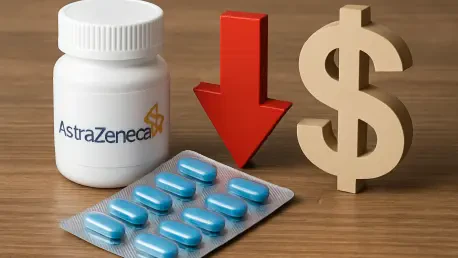In a nation where millions of Americans ration life-saving medications due to staggering costs, and communities yearn for stable, high-paying jobs, one pharmaceutical giant is stepping up with a groundbreaking plan. AstraZeneca, a global leader in healthcare, has struck a historic agreement with the US government to tackle these twin crises head-on. This isn’t just another corporate promise—it’s a sweeping initiative that could redefine how the industry balances profit with purpose, offering a glimmer of hope to patients and workers alike.
Why Drug Costs and Jobs Matter Now More Than Ever
The spotlight on prescription drug prices and domestic employment has never been brighter. With many Americans spending thousands annually on essential treatments, the financial strain often leads to skipped doses or untreated conditions, particularly for those with chronic illnesses like diabetes or cancer. At the same time, the call to strengthen the US economy through local manufacturing resonates across political and social spheres, as global supply chain disruptions expose vulnerabilities in outsourcing.
This dual challenge represents more than just policy debates—it’s about real lives. Families are forced to make heartbreaking decisions between healthcare and basic needs, while entire towns ache for the economic revival that new industries can bring. AstraZeneca’s latest commitment emerges as a potential turning point, addressing these deeply personal and national priorities with a single, ambitious strategy.
The Heavy Toll of High Prices and Economic Need
The impact of exorbitant drug costs cuts deep, with studies showing that nearly 1 in 4 Americans struggle to afford their prescriptions, often leading to worsening health outcomes. For someone battling a life-threatening disease, the price tag on a single medication can mean the difference between recovery and despair. This crisis disproportionately affects vulnerable populations, amplifying inequalities in access to care.
On the economic front, the push for domestic production has gained urgency as a way to rebuild resilience. Bringing manufacturing back to American soil not only promises job creation but also secures critical supply chains for medicines—a lesson learned hard during recent global shortages. AstraZeneca’s alignment with these goals positions the company at the forefront of a movement that could reshape both healthcare access and economic stability.
AstraZeneca’s Dual Blueprint for Change
AstraZeneca’s approach splits into two transformative paths: slashing costs for patients and fueling growth through US investments. On affordability, the company has launched direct-to-consumer sales, offering discounts of up to 80% off list prices for eligible patients on select medicines. Additionally, reduced cash prices are now available through a government platform, targeting immediate financial relief for those burdened by high out-of-pocket costs.
Economically, a staggering $50 billion investment is underway to expand US-based operations. This includes new facilities in states like Virginia, where a $4.5 billion manufacturing site is already taking shape, and Texas, with construction set to start soon. Further plans include a cutting-edge cell therapy center in Maryland, breaking ground in early 2026, and a major research hub in Massachusetts slated for late 2026. Building on their 19 existing US sites, which employ over 25,000 people and contribute $20 billion annually to the economy, these projects signal a long-term commitment to American workers.
The scope of this initiative stands out for its precision and scale. Each project comes with clear timelines and measurable impacts, from job creation to enhanced drug production capacity. This isn’t just about corporate optics—it’s a calculated effort to address systemic issues while strengthening the company’s foothold in the US market.
Leadership Insights and Broader Implications
Pascal Soriot, AstraZeneca’s CEO, has been vocal about the company’s mission, declaring, “The goal is clear: treat millions of Americans with access to life-changing medicines at reduced costs.” This statement, made following high-level discussions with the US President and government officials, underscores a shared vision for change. The agreement itself stems from a pivotal call to action in a July 31 letter from the President to the pharmaceutical sector, urging lower prices and domestic investment.
Beyond rhetoric, the deal includes practical support, such as a three-year delay on Section 232 tariffs, negotiated with the Department of Commerce. This extension gives AstraZeneca critical breathing room to advance its onshoring plans without the immediate burden of added costs. Such collaboration between industry and government hints at a new era of partnership, one that prioritizes both patient welfare and national economic goals.
The ripple effects of this commitment are already being felt. Industry watchers note that AstraZeneca’s actions could pressure competitors to adopt similar measures, potentially transforming how drug pricing and production are approached. This alignment of corporate strategy with public need offers a rare glimpse into what systemic reform might look like.
What This Means for Patients and Communities
For those struggling with medication costs, AstraZeneca’s initiatives bring tangible hope. Patients can check eligibility for steep discounts through direct-to-consumer programs or explore lower cash prices on a government platform, easing the financial weight of essential treatments. These steps are designed to deliver relief now, not years down the line, making a direct impact on daily lives.
Communities near the expanding facilities stand to gain as well. With new jobs on the horizon in states like Virginia, Texas, Maryland, and Massachusetts, local economies could see a significant boost through 2026 and beyond. Residents in these areas are encouraged to monitor openings as construction progresses, offering a chance to join a growing workforce in high-demand fields like manufacturing and research.
Looking ahead, this model of balancing affordability with domestic growth could set a powerful precedent. If other pharmaceutical giants follow suit, the industry might witness a shift toward more equitable pricing and localized production. The evolving partnership between government and private sectors bears watching, as it may redefine the intersection of healthcare policy and economic development for years to come.
Reflecting on a Historic Step Forward
Looking back, AstraZeneca’s agreement with the US government marked a defining moment in addressing the intertwined challenges of drug affordability and job creation. The bold discounts provided relief to countless patients, while the massive investments in American infrastructure laid the groundwork for sustained economic growth. This dual focus demonstrated what was possible when industry and public interests aligned.
The path forward demands continued vigilance and collaboration. Stakeholders need to ensure that such initiatives expand, pushing for broader access to discounted medications and more opportunities for domestic employment. Tracking the progress of these facilities and pricing programs becomes essential, as does advocating for other companies to adopt similar frameworks. This journey, though just beginning, offers a blueprint for tackling systemic issues with innovative, actionable solutions.









